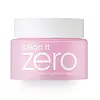What's inside
What's inside
 Key Ingredients
Key Ingredients

 Benefits
Benefits

 Concerns
Concerns

 Ingredients Side-by-side
Ingredients Side-by-side

Ethylhexyl Palmitate
EmollientCetyl Ethylhexanoate
EmollientPEG-20 Glyceryl Triisostearate
EmollientPEG-10 Isostearate
EmulsifyingSynthetic Wax
AbrasiveOnsen-Sui
Phenoxyethanol
PreservativeButylene Glycol
HumectantLithospermum Erythrorhizon Root Extract
Skin ConditioningTocopheryl Acetate
AntioxidantParfum
MaskingEthylhexylglycerin
Skin ConditioningWater
Skin Conditioning1,2-Hexanediol
Skin ConditioningBambusa Vulgaris Leaf/Stem Extract
HumectantAspalathus Linearis Extract
Skin ConditioningAngelica Archangelica Root Extract
MaskingMalpighia Glabra Fruit Extract
Skin ConditioningPolydiethyleneglycol Adipate/Ipdi Copolymer
Acrylates/Ammonium Methacrylate Copolymer
Acrylates/Methoxy PEG-15 Methacrylate Copolymer
Ethylhexyl Palmitate, Cetyl Ethylhexanoate, PEG-20 Glyceryl Triisostearate, PEG-10 Isostearate, Synthetic Wax, Onsen-Sui, Phenoxyethanol, Butylene Glycol, Lithospermum Erythrorhizon Root Extract, Tocopheryl Acetate, Parfum, Ethylhexylglycerin, Water, 1,2-Hexanediol, Bambusa Vulgaris Leaf/Stem Extract, Aspalathus Linearis Extract, Angelica Archangelica Root Extract, Malpighia Glabra Fruit Extract, Polydiethyleneglycol Adipate/Ipdi Copolymer, Acrylates/Ammonium Methacrylate Copolymer, Acrylates/Methoxy PEG-15 Methacrylate Copolymer
Water
Skin ConditioningPropanediol
SolventGlycerin
HumectantGlycereth-26
HumectantHexylene Glycol
EmulsifyingPolysorbate 20
Emulsifying1,2-Hexanediol
Skin ConditioningDisodium Cocoamphodiacetate
CleansingSodium Citrate
BufferingDisodium EDTA
Ethylhexylglycerin
Skin ConditioningSodium Chloride
MaskingParfum
MaskingCitric Acid
BufferingCamellia Sinensis Leaf Extract
AntimicrobialCamellia Sinensis Leaf Water
MaskingLinalool
PerfumingLimonene
PerfumingButylene Glycol
HumectantCamellia Sinensis Root Extract
PerfumingTocopherol
AntioxidantWater, Propanediol, Glycerin, Glycereth-26, Hexylene Glycol, Polysorbate 20, 1,2-Hexanediol, Disodium Cocoamphodiacetate, Sodium Citrate, Disodium EDTA, Ethylhexylglycerin, Sodium Chloride, Parfum, Citric Acid, Camellia Sinensis Leaf Extract, Camellia Sinensis Leaf Water, Linalool, Limonene, Butylene Glycol, Camellia Sinensis Root Extract, Tocopherol
 Reviews
Reviews

Ingredients Explained
These ingredients are found in both products.
Ingredients higher up in an ingredient list are typically present in a larger amount.
1,2-Hexanediol is a synthetic liquid and another multi-functional powerhouse.
It is a:
- Humectant, drawing moisture into the skin
- Emollient, helping to soften skin
- Solvent, dispersing and stabilizing formulas
- Preservative booster, enhancing the antimicrobial activity of other preservatives
Butylene Glycol (or BG) is used within cosmetic products for a few different reasons:
Overall, Butylene Glycol is a safe and well-rounded ingredient that works well with other ingredients.
Though this ingredient works well with most skin types, some people with sensitive skin may experience a reaction such as allergic rashes, closed comedones, or itchiness.
Learn more about Butylene GlycolEthylhexylglycerin (we can't pronounce this either) is commonly used as a preservative and skin softener. It is derived from glyceryl.
You might see Ethylhexylglycerin often paired with other preservatives such as phenoxyethanol. Ethylhexylglycerin has been found to increase the effectiveness of these other preservatives.
Parfum is a catch-all term for an ingredient or more that is used to give a scent to products.
Also called "fragrance", this ingredient can be a blend of hundreds of chemicals or plant oils. This means every product with "fragrance" or "parfum" in the ingredients list is a different mixture.
For instance, Habanolide is a proprietary trade name for a specific aroma chemical. When used as a fragrance ingredient in cosmetics, most aroma chemicals fall under the broad labeling category of “FRAGRANCE” or “PARFUM” according to EU and US regulations.
The term 'parfum' or 'fragrance' is not regulated in many countries. In many cases, it is up to the brand to define this term.
For instance, many brands choose to label themselves as "fragrance-free" because they are not using synthetic fragrances. However, their products may still contain ingredients such as essential oils that are considered a fragrance by INCI standards.
One example is Calendula flower extract. Calendula is an essential oil that still imparts a scent or 'fragrance'.
Depending on the blend, the ingredients in the mixture can cause allergies and sensitivities on the skin. Some ingredients that are known EU allergens include linalool and citronellol.
Parfum can also be used to mask or cover an unpleasant scent.
The bottom line is: not all fragrances/parfum/ingredients are created equally. If you are worried about fragrances, we recommend taking a closer look at an ingredient. And of course, we always recommend speaking with a professional.
Learn more about ParfumWater. It's the most common cosmetic ingredient of all. You'll usually see it at the top of ingredient lists, meaning that it makes up the largest part of the product.
So why is it so popular? Water most often acts as a solvent - this means that it helps dissolve other ingredients into the formulation.
You'll also recognize water as that liquid we all need to stay alive. If you see this, drink a glass of water. Stay hydrated!
Learn more about Water